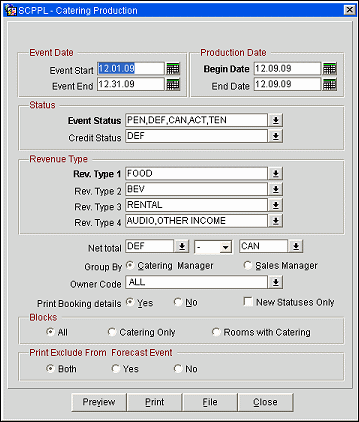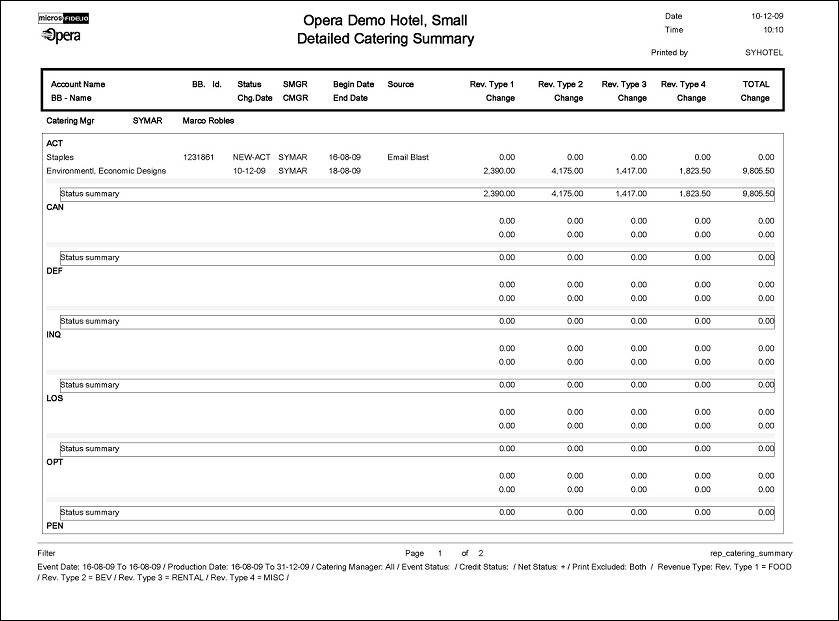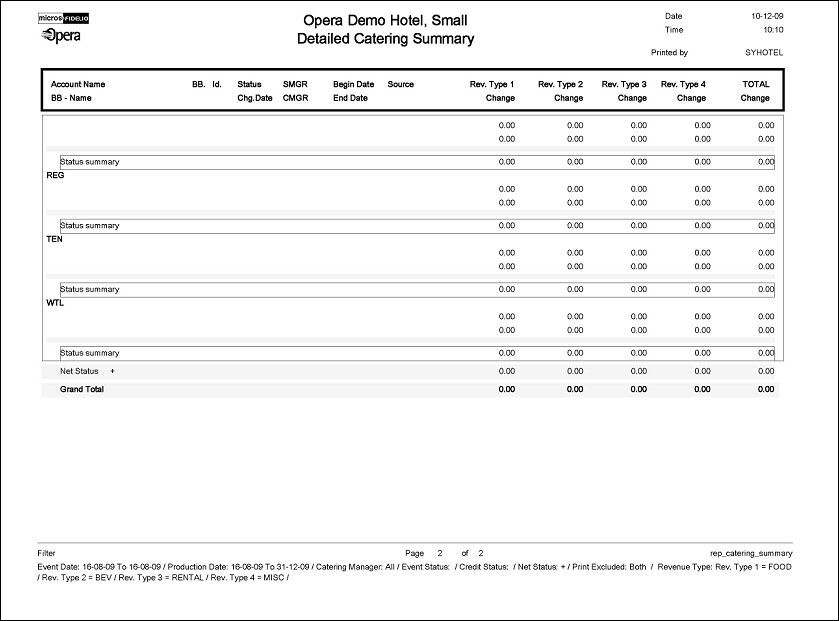
Catering Summary Report (REP_CATERING_SUMMARY.REP with REP_CATERING_SUMMARY.FMX)
This production report calculates the catering revenue changes for all bookings that have had events created on a specified status, events which had their status changed to a specified status or events which were on the specified status before the production period, but had changes done to their revenue in the production period. The figures are calculated and displayed on a booking-by-booking basis. If a booking has events of different statuses that all fall into the production criteria, the booking name will be listed underneath all these statuses. The report can be sorted and grouped either by room owner or by catering owner, and sub- totals will be supplied by group.
This report has the option to select a credit status. This means that events can be accounted for in the selected credit status even if they moved on to another follow on status in the same production period. I.e. If an event becomes both DEFINITE and ACTUAL in the selected production period, if DEFINITE is selected as credit status, the event will show up under the status section for DEFINITE and ACTUAL both rather than just under ACTUAL, which would be the last status. This helps greatly in calculating Sales Managers incentives that are usually based on a defined credit status.
Note: When printing this Report help topic, we recommend printing with Landscape page orientation.
Note: This report requires that the user be granted the EVENT PRINT permission in the selected property to run the report. Also, the Property LOV in this report is further limited by the properties to which the user has the appropriate access granted.

Property. Available when OPS_MHT2 license is active. Choose the property for which the report should be printed.
Event Date (Event Start/Event End). The event date range that should be covered in this report.
Production Date (Start/End). Defines the date range for which event changes should be recorded. Each change that is done to an event status or to catering revenue is recorded in a specific event production change log. The Production Date Range filter will scan the entries in this production change log to search for any event changes that fall under the other criteria that have been selected on the filter form. By the nature of this date range filter, only dates in the past are valid entries, because there cannot be any entries in the event change log after the current business date. To illustrate the above, an event that gets created on status TEN in April 2003 with Event Date in October 2003 can turn to status DEF in June 2003. In the above scenario there would be two entries in the change log for this event, one for the creation of the event on status TEN in production period April 2003 and one for the status change to DEF in June 2003.
Note: The production period is mandatory for this report.
Event Status. Please make sure that the Credit Status filter and the Event Status filter do not contradict each other. For example, if the credit status would be defined as DEF and the Event Statuses selected are INQ and TEN, nothing would be recorded under the credit status section, if DEF is a status that follows INQ or TEN in the status flow.
However, if the Event Status filter is used to select statuses DEF, CAN, ACT and DEF as the credit status, this report would correctly record those events in the credit status section that are either still on status DEF at the end of the production period, or that moved through the status DEF into either status CAN or ACT in the same production period.
Note: When the Exclude from Forecast Reports flag is checked on the Details tab of the Event screen, the event for which the flag was set will not be included in this report.
Credit Status. Defines the status code that an event should be recorded on in any case, irrespectively of if the event is still on that status at the end of the production period or has moved on.
For example, an event with 200.00 USD Food Revenue turns DEF in April 2003. In May 2003 100.00 USD Food Revenue are added to the booking. Still in May 2003 (i.e., some days after the revenue is added) the event turns ACT. If no credit status is selected, the event is on this report only included in the section for status ACTUAL with a total of 300.00USD Food Revenue (the original 200.00 USD plus the 100.00USD added in May). If the credit status is defined as DEF, the event will show up twice on this report if it is ordered for production period May 2003. Once under the status section for DEF with 100.00 USD Food Revenue change (because 100.00 USD were added while the event was still on the credit status) and once on the section for ACT with 300.00 USD. If the event had turned DEF in May 2003 instead of in April 2003, it would again show up twice if the credit status was DEF. Once as DEF with 300.00 USD, and once as ACT, also with 300.00 USD.
Revenue Types 1-4. Allows the selection of up to four catering revenue types, or combinations of revenue types that changes should get reported for. Descriptions of the selected revenue types will display in the report footer.
Note: When the application parameter Use Forecast Value Only is set to Y and an Event has an F&B Minimum Rate Code attached, forecasted revenue will not be reported or recorded for the Revenue Types that are configured to contribute to the F&B Minimum. If the Rate Code is changed to one that does not require a minimum and expected revenue has not been added to those revenue types, the forecasted revenue for revenue types configured to contribute to the F&B Minimum will be reported.
Net Total. Allows specification of a NET revenue figure that should get reported per group. For example, if statuses, INQ, TEN, DEF, LOS and CAN were selected to be reported on and DEF is credit status (most typical scenario), it would make sense to define the net total as DEF minus CAN.
Group By (Catering Manager/Sales Manager). As mentioned above, the report can be grouped on catering manager or sales manager. Sub-total and net totals are calculated per group.
Owner Code. Allows selection of specific manager initials only.
Print Booking Details?. If Yes is selected each booking that falls within the selected parameters will print separately onto the report with a sub-total per status and net total per selected group. If No is selected, only the summary per status and the net total will print within each group, without any booking details.
New Statuses Only. When checked, only those bookings will be reported that have had a status change occurring in the selected production period. Bookings that only underwent or revenue changes will be omitted.
Blocks (All/Catering Only/Rooms with Catering). Use this option to filter results for Blocks that have been flagged as 'Catering Only', Blocks that have not been flagged as 'Catering Only', or All Blocks.
Print Exclude from Forecast Event - Both/Yes/No. Select this option to either include or exclude certain events. When Both is selected all qualifying events will print. When Yes is selected, only events that have had the Exclude from Forecast Reports flag checked will print (the Exclude from Forecast Reports flag is accessible on the Events Screen Details tab). When No is selected only events that have NOT been marked as Exclude from Forecast Reports will print.
Preview. Use the preview option to view the generated output of this report in PDF format.
Print. Use the Print button to print the report to the selected output.
File. Prints the generated report output to an *.rtf file.
Close. Closes this report screen.
The report will print one record for each booking that fits the filter criteria provided that the ‘Print Booking Details?’ radio button Yes has been selected. The booking must have at least one event that was created or changed in the production period. If the booking has several events of different event statuses, the booking record will be printed in each appropriate status section once with the total production per event status. The report is grouped primarily on the group defined in filter options. Within each main group, bookings are then automatically grouped by event status. The selected sort group header is printed above each section (i.e. rooms owner initial or catering owner initial). Data printed for each booking includes account name, booking name, internal booking ID, rooms owner code, catering owner code, booking arrival date, booking departure date and booking source.
Note: Accounts and contacts will use the following logic when printing on this report. If a Company profile is attached to the booking, then the Company profile will print. If no Company profile is attached, but an Agent profile is present, then the Agent profile will print. If no Company and no Agent profiles are attached, but Source profile is present, then the Source profile will print.
If a booking is lost or cancelled, the date the booking was lost or cancelled will print as well as the reason for the cancellation. For each booking two rows of figures are recorded. The upper row shows the total catering revenue for each type or combination of types selected on the report filter form, for the booking at the end of the production period, including the changes that have been made to this booking in the production period. The second row ONLY represents the changes that have been made to the booking catering revenue, again by type or combination of types in the production period.
If the event status was changed in the production period the total revenue figures for this event will be added as a change. A status change is always considered a roll-over of all existing revenues into the new status and therefore all revenue on the books at the end of the production period is considered changes within the production period.
If a credit status has been defined in the filter form, events that went through the credit status and into a follow on status of the credit status (or had changes done to them while on the credit status in the production period and then turned into a follow on status still in the same production period) will be reported twice on this report, once under the credit status and once under the last status of the event.
Events will not show more than twice though. If a possible status flow was TEN to DEF to ACT and a booking went through all three statuses in the same production period, it would only show for the credit status (if one has been defined) and the last status the event is on at the end of the production period. If the credit status was equal to the last status of the event, it would show only once.
The report will print a summary line for each defined main sort group. It will show the total revenue as defined in the net total calculation on the report form.
Please also note that forecast figures are calculated as event production for this report if no expected, guaranteed or actual figures exist for a specific revenue type. For example, if an event had forecasted revenue for 500.00 USD Room Rental, 1000.00 USD for Food and 100.00 USD for Decoration, but only the function space is booked at a rate of 450.00 USD when the event becomes DEF, the revenue recorded in this report as production on the status change will still be 450.00 USD Rental, 1000.00 USD Food and 400.00 USD Decoration.

